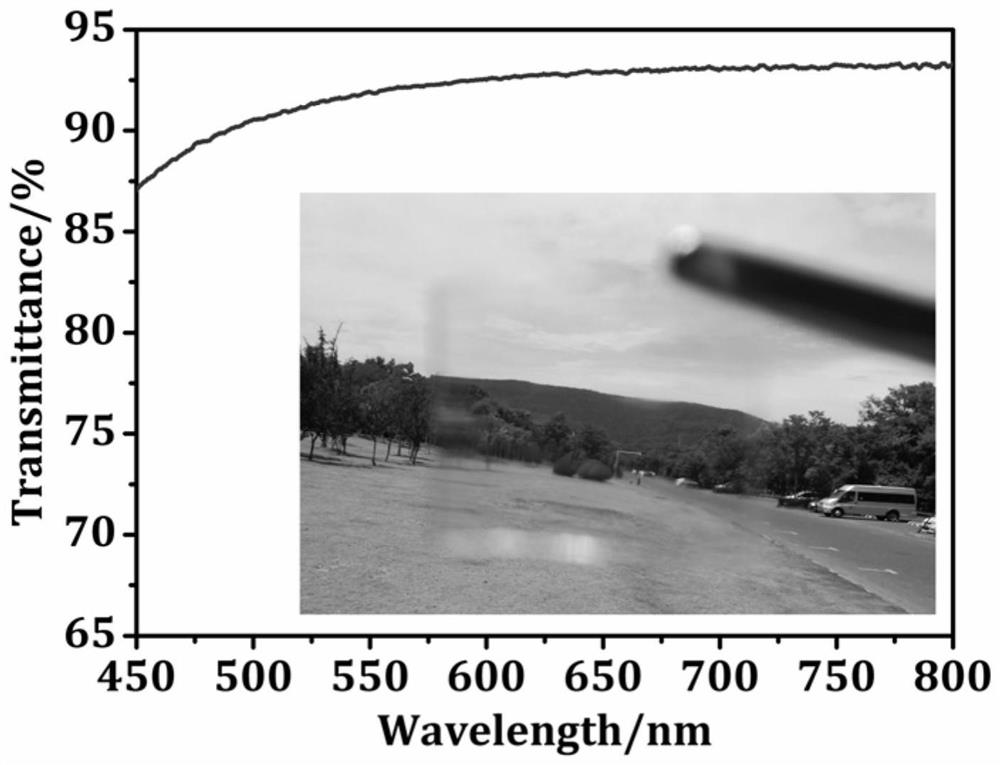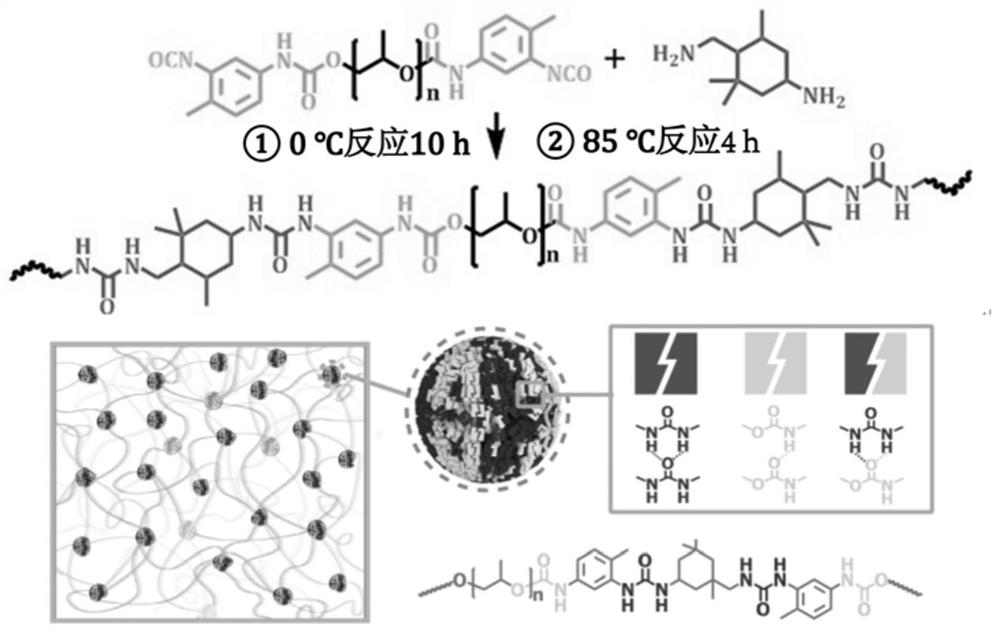Ultra-tough room temperature intrinsic self-healing elastomer material with high light transmittance and preparation method thereof
A technology of elastomer materials and high light transmittance, applied in the field of elastomer materials, can solve the problems that it is difficult to balance mechanical properties and self-repair effects, cannot achieve ultra-high repair efficiency, and cannot meet application scenarios, etc., to achieve excellent self-repair Capability, stable repeatability, and high productivity
- Summary
- Abstract
- Description
- Claims
- Application Information
AI Technical Summary
Problems solved by technology
Method used
Image
Examples
Embodiment 1
[0040]A method for preparing a super-tough room temperature intrinsically self-healing elastomer material with high light transmittance, the specific steps are as follows:
[0041] a. Under an inert gas atmosphere, 6.9 g of toluene diisocyanate-terminated polypropylene glycol (molecular weight: 2300) was dissolved in 20 mL of N, N'-dimethylformamide solvent to prepare mixed solution I;
[0042] b. Dissolve 0.485g of isophoronediamine in 10mL of N,N'-dimethylformamide solvent to prepare the mixed solution II, and then add the mixed solution II dropwise at 0-4°C to prepare in step a In the obtained mixed solution I, the dropping rate was 1000 μL / min, and the stirring reaction was carried out for 10 h to obtain the initial reaction product solution III, wherein the molar ratio of toluene diisocyanate-terminated polypropylene glycol to isophorone diamine was 100:95;
[0043] c. heating the initial reaction product solution III prepared in step b at 85° C. for 4 hours to obtain the...
Embodiment 2
[0047] A method for preparing a super-tough room temperature intrinsically self-healing elastomer material with high light transmittance, the specific steps are as follows:
[0048] a. Under an inert gas atmosphere, dissolve 6.9 g of toluene diisocyanate-terminated polypropylene glycol in 20 mL of N,N'-dimethylformamide solvent to prepare a mixed solution I;
[0049] b. Dissolve 0.485g of isophoronediamine in 10mL of N,N'-dimethylformamide solvent to prepare the mixed solution II, and then add the mixed solution II dropwise at 0-4°C to prepare in step a In the obtained mixed solution I, the rate of addition was 1000 μL / min, and the reaction was stirred for 10 hours to obtain the initial reaction product solution III. Wherein the mol ratio of toluene diisocyanate-terminated polypropylene glycol and isophorone diamine is 100:95;
[0050] c. heating the initial reaction product solution III prepared in step b at 70° C. for 6 hours to obtain the initial reaction product solution ...
Embodiment 3
[0054] A method for preparing a super-tough room temperature intrinsically self-healing elastomer material with high light transmittance, the specific steps are as follows:
[0055] a. Under an inert gas atmosphere, dissolve 6.9 g of toluene diisocyanate-terminated polypropylene glycol in 20 mL of N,N'-dimethylformamide solvent to prepare a mixed solution I;
[0056] b. Dissolve 0.511g of isophoronediamine in 10mL of N,N'-dimethylformamide solvent to prepare mixed solution II, and then add mixed solution II dropwise at 0-4°C to prepare in step a In the obtained mixed solution I, the rate of addition was 1000 μL / min, and the reaction was stirred for 10 hours to obtain the initial reaction product solution III. Wherein the mol ratio of toluene diisocyanate-terminated polypropylene glycol and isophorone diamine is 100:100;
[0057] c. heating the initial reaction product solution III prepared in step b at 90° C. for 3 hours to obtain the initial reaction product solution IV;
...
PUM
| Property | Measurement | Unit |
|---|---|---|
| concentration | aaaaa | aaaaa |
| tensile strength | aaaaa | aaaaa |
| concentration | aaaaa | aaaaa |
Abstract
Description
Claims
Application Information
 Login to View More
Login to View More - R&D
- Intellectual Property
- Life Sciences
- Materials
- Tech Scout
- Unparalleled Data Quality
- Higher Quality Content
- 60% Fewer Hallucinations
Browse by: Latest US Patents, China's latest patents, Technical Efficacy Thesaurus, Application Domain, Technology Topic, Popular Technical Reports.
© 2025 PatSnap. All rights reserved.Legal|Privacy policy|Modern Slavery Act Transparency Statement|Sitemap|About US| Contact US: help@patsnap.com



